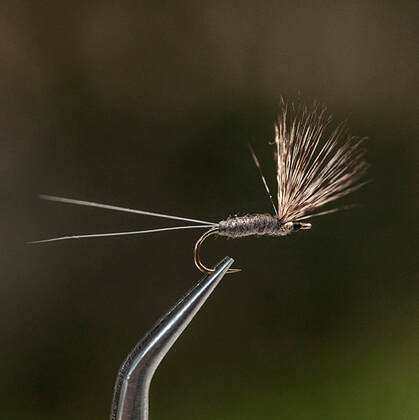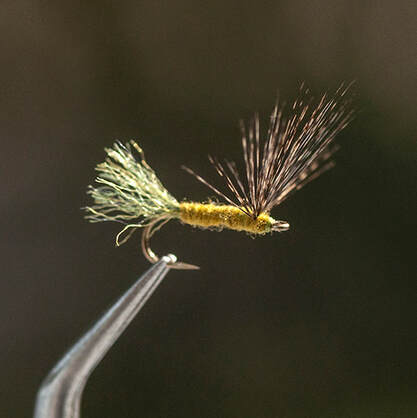Fly of the Month 08.21 - CDL Comparadun
CDL or Coq De Leon feathers are from a specific region in Spain. Initially raised in a monastery in about 1620. CDL feathers are stiff, glassy and long straight fibers that have been bred in two primary colors, browns (or pardos) and grays (indios) with further color variations of the two such that there are 5 browns and 5 grays to select from when purchasing from a we supplies fly shop or warehouse. The actual CDL feathers are spade hackles from the shoulder of the bird.
Early fly patterns utilizing CDL feathers were often Scottish and Irish dapping flies. Some early CDL fly patterns typically resemble our modern day soft hackle fly patterns such as the Partridge & orange or Partridge & green. The translucence of the material makes the fibers useful for applications as a tail, for wings and as a Comparadun style dry fly pattern
CDL Comparadun
CDL Sparkle Dun
The Comparadun is typically tied with deer body hair, utilizing the stiffness and high buoyancy of the hollow deer hair. CDL feathers have similar and comparable qualities of stiffness and high buoyancy due to the natural oils in the feathers. Substitute CDL feather fibers for the deer body hair in both the tail and the wings. For the CDL Sparkle Dun, only the wings are substituted.
Some example CDL fly patterns include CDL Mayfly Parachute, CDL Hen Caddis Emerger, the Americanchie, and the CDL Frenchie Soft Hackle. CDL Feather fibers may be substituted in almost any fly pattern that uses stiff hair components.
Fly of the Month 08.21
Tom Adams and Alen Baker
CDL or Coq De Leon feathers are from a specific region in Spain. Initially raised in a monastery in about 1620. CDL feathers are stiff, glassy and long straight fibers that have been bred in two primary colors, browns (or pardos) and grays (indios) with further color variations of the two such that there are 5 browns and 5 grays to select from when purchasing from a we supplies fly shop or warehouse. The actual CDL feathers are spade hackles from the shoulder of the bird.
Early fly patterns utilizing CDL feathers were often Scottish and Irish dapping flies. Some early CDL fly patterns typically resemble our modern day soft hackle fly patterns such as the Partridge & orange or Partridge & green. The translucence of the material makes the fibers useful for applications as a tail, for wings and as a Comparadun style dry fly pattern
CDL Comparadun
CDL Sparkle Dun
The Comparadun is typically tied with deer body hair, utilizing the stiffness and high buoyancy of the hollow deer hair. CDL feathers have similar and comparable qualities of stiffness and high buoyancy due to the natural oils in the feathers. Substitute CDL feather fibers for the deer body hair in both the tail and the wings. For the CDL Sparkle Dun, only the wings are substituted.
Some example CDL fly patterns include CDL Mayfly Parachute, CDL Hen Caddis Emerger, the Americanchie, and the CDL Frenchie Soft Hackle. CDL Feather fibers may be substituted in almost any fly pattern that uses stiff hair components.
Fly of the Month 08.21
Tom Adams and Alen Baker
Recipe:
CDL Comparadun
Hook: Dry, Size 12,14,16,18
Thread: 8/0 to match
Wing: CDL Rooster barbs
Abdomen: Dry fly dubbing to match
Thorax: Dry fly dubbing to match
Tail: Microfibbetts to match
NOTE: This pattern can be tied to fish as many insects. BWO, Mahogany, Sulphur, PMD etc, therefore there are no specific colors listed. NOTE: A CDL Sparkle Dun is tied the same as this but with the tail being Zelon
Directions :
Hook: Dry, Size 12,14,16,18
Thread: 8/0 to match
Wing: CDL Rooster barbs
Abdomen: Dry fly dubbing to match
Thorax: Dry fly dubbing to match
Tail: Microfibbetts to match
NOTE: This pattern can be tied to fish as many insects. BWO, Mahogany, Sulphur, PMD etc, therefore there are no specific colors listed. NOTE: A CDL Sparkle Dun is tied the same as this but with the tail being Zelon
Directions :
- Debarb and mount the hook in the vise and start the thread wraps at the eye. Make several wraps toward the bend to about the one third mark. Let the bobbin hang.
- Select a CDL feather and stroke the barbs to stand at a right angle to the stem. This will aid in alignment when removing. Gather a substantial number of barbs with your index and thumb and holding the tip of the stem with the other hand, pull the barbs away. There will be a curly end on the barbs when removed. Still holding the aligned tips use scissors to trim away the curlies and place the barbs into a small hair stacker tips first.
- If tying larger than an 18 it will most likely be necessary to repeat the process to gain enough barbs. Tap the stacker to align the barbs and remove gently to maintain the alignment. Place the barbs on top of the hook shank and secure, first with a pinch wrap and then with several firm wraps going toward the bend. Once secure, make one or two wraps immediately in front of the barbs forcing them to somewhat of an upright position. Don’t worry at this time about being at ninety degrees. Make tight and touching turns of thread to finish securing the barbs behind the wing and trim away any excess length. Let the bobbin hang.
- Select two fibbets and remove from the bundle, while keeping the tips aligned. Measure the length to slightly longer than the hook shank and tie in on top of the hook. After placing and partially securing on top take the thread under the fibbets an pull the thread parallel to the shank lifting the tail slightly. Make one wrap at the tie in and then make a x wrap between the fibbets to spread them. Make tight touching turns to even out the abdomen returning to the hook bend and let the bobbin hang.
- Select a wisp of dubbing and form a tight noodle. Form a tapered dub to the eye, dubbing the body with tight touching turns of dub advancing to in front of the wing.
- Secure the thread with a four turn whip finish and trim.
- Using your thumbnail or scissors, push the wing to a vertical position by applying pressure at their base and spread to 180 degrees.


